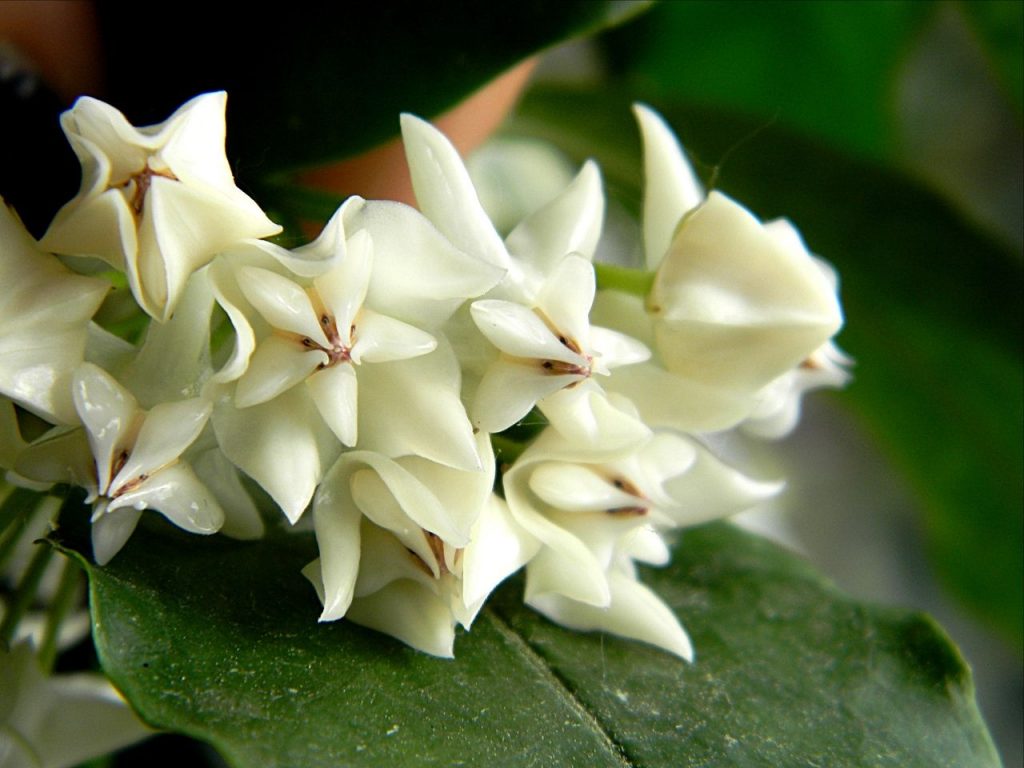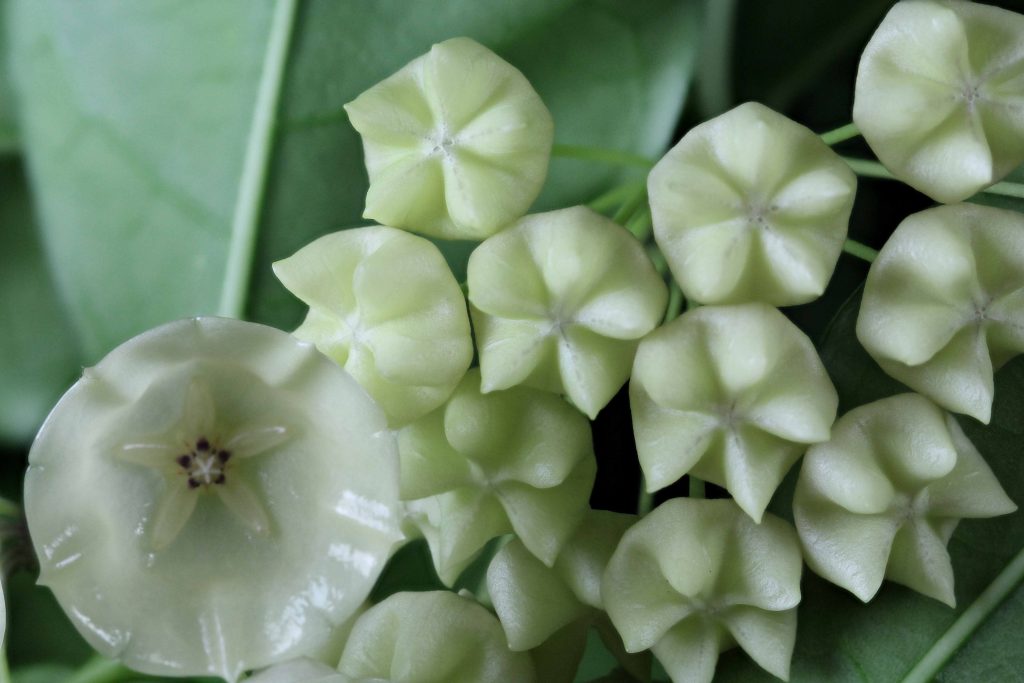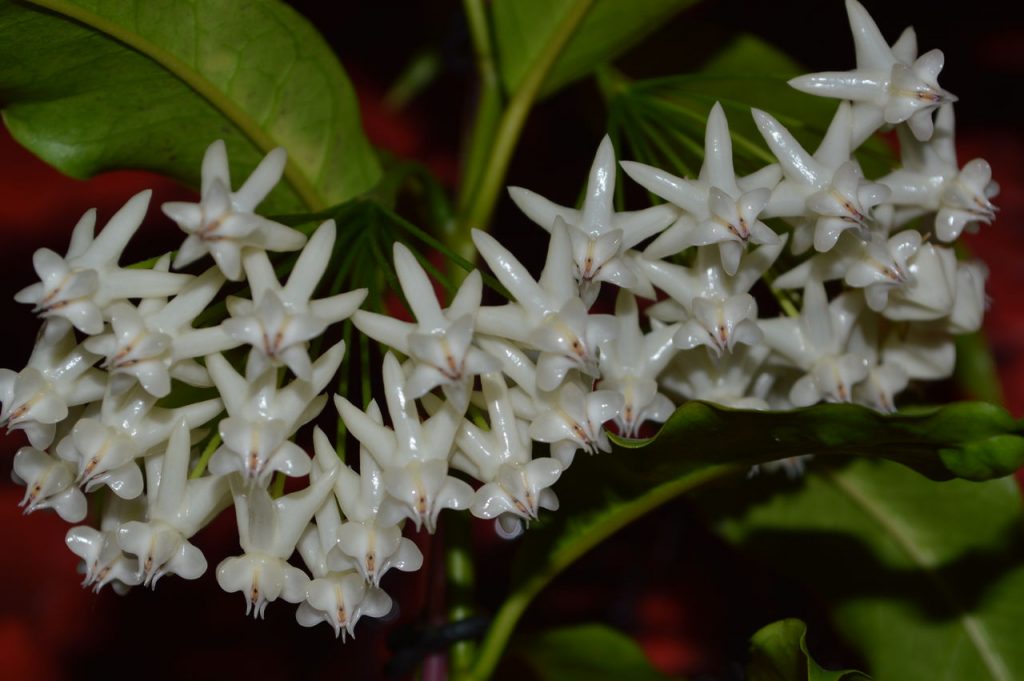Hoya Loki is a wonderful houseplant
Loki's graceful hoya looks very similar to the multiflora variety, but is considered much more attractive. The plant got this name thanks to its discoverer - Thomas Hoye. Homeland of origin - tropical zones of Asia, Africa and the Philippines. Consider the features of culture and the rules for caring for it at home.

Characteristic
Hoya Loki belongs to the Lastovnevye family.
Flower description:
- stems are cylindrical, thin (2-3 mm in diameter), green;
- in young plants, the shoots are erect, in adults they droop, therefore they need support;
- oval leaves, pointed at the end, length - 10-12 cm, smooth surface, rich green color;
- lush, umbrella-shaped inflorescences form at the tips of the branches;
- flowers are small, two-tiered, snow-white, consist of narrow petals, bent outward;
- each bud contains a five-pointed crown in purple or violet tones.
Long-lasting flowering - begins in spring and ends in late summer. During this period of life, the plant thinns a pleasant sweetish aroma.
Purchase and adaptation
You can buy Loki hoya at any flower shop. To make sure you are looking at a true variety, choose a flowering plant.
In healthy specimens:
- shoots are flexible, uniform in color, smooth, without growths, black spots and cracks;
- the leaves are juicy, bright green, without yellowing, drying out at the tips and holes on the surface;
- the soil is not overdried, does not contain mold, plaque and acidification.
Purchased hoya is kept in quarantine for three weeks. This will help him quickly adapt to new growth conditions. During this time, you can understand if he has diseases and parasites. If they are found, it is necessary to carry out treatment with pesticides. A week after treatment, the flower is transferred to a common room with other vegetation.
Landing rules
Full growth, lush flowering of this variety depends on the substrate and habitat. The soil is used light, loose and fertile. Several ingredients are mixed - sod land, coarse sand, peat and humus in a ratio of 2: 1: 1: 1.
For planting, you can take ready-made store soil intended for decorative flowering plants.
Before putting it in a pot, it is calcined in an oven for half an hour at a temperature of 100 ° C, spilled with boiling water, a solution of fungicide or potassium permanganate. Such treatment will help to destroy all pathogenic microflora.
Hoya should be placed in a warm place with diffused daylight - a window from the south or southwest side will do.
If necessary, at lunchtime, the plant is shaded from direct sunlight. If kept on the north window, additional lighting with a lamp will be required.
The necessary conditions
To achieve high decorativeness and maintain immunity at the desired level, the plant needs to be provided with several conditions of detention.

Humidity
Loves high humidity and does not tolerate dry air. Therefore, in the phase of active growth, it is regularly sprayed with warm water from a spray bottle - every second day.
With the arrival of autumn and until the end of winter, the frequency of sprinkling is reduced to once a month. This procedure stimulates the growth of stems, leaves, removes dust from the leaves and prevents the appearance of spider mites.
Temperature
Depending on the season, they provide a different regime at home:
- in spring and summer - within 22-27 ° С;
- in autumn and winter - 15-16 ° С.
The flower loves fresh air, but does not tolerate sudden changes in temperature. The room is regularly ventilated, but before that the plant is taken out to another room.
Lighting
In order for the hoya to retain the decorativeness of the leaves and for a long time, colorfully, it needs to provide bright diffused light throughout the year. The optimal duration is 10 hours a day.
In the warm season, it is placed on a balcony, loggia or terrace, where there are no scorching rays, and there is protection from drafts and precipitation. In winter, when the day is shorter, it is supplemented with a fluorescent lamp.
Care features
Correct and timely care promotes rapid growth, high-quality flowering and increases resistance against diseases.

Watering
This variety does not like waterlogging, so it should be watered sparingly, but regularly. You can determine the need for moisture by the state of the substrate - if it has dried out to a depth of 3-4 cm, it should be moistened.
In spring and summer - the frequency is once every 5-7 days. In the cold season - every 2-3 weeks.
Use settled or filtered water at room temperature.
After watering, it is advisable to loosen, so the substrate will pass oxygen and moisture well.
Top dressing
Fertilize the entire growing season - from early March to late August. Use ready-made complex formulations that contain nitrogen, phosphorus and potassium. Brought in once every two weeks. Combine with watering in order to prevent scalding of the roots, and to improve the degree of absorption of nutrients.
Pruning
This flower does not require shaping, since it does not differ in intensive growth and does not tolerate this procedure well.

From spring to autumn, it is necessary to cut off twigs, leaves that have become yellow, dry, began to rot or are damaged by diseases.
Use a sterile and well-sharpened instrument. Places of cuts are sprinkled with charcoal to prevent infection.
Transfer
A ceramic or plastic pot is suitable for transplanting a little larger than the size of the old container. There should be drain holes at the bottom. A couple of handfuls of expanded clay are laid, then the fertile composition used for planting. The purchased flower is watered, removed and, together with a lump of earth, transferred into a new flowerpot. If necessary, the soil is poured to the top, tamped, moistened.
Also, young plants need transplanting - every second year, and adults - after 3-4 years.
If the root system of the hoya begins to rot, it also needs to be transplanted. The technique of the procedure is as follows:
- watered, after a while removed and dipped in a basin of water to wash off the remnants of the earth;
- dried, all rotten roots are cut out to healthy tissue;
- dipped for 2 hours in a fungicide solution;
- after drying, sprinkle with charcoal;
- planted in a new pot with disinfected soil.
Reproduction methods
Reproduction of the lianoid hoya lokka is carried out in several ways - each gives a positive result, subject to all the rules.

Cuttings
Shoots are cut from the top of the stems in the spring. The optimal length is 12-15 cm. Each segment should have 2 leaves and the same number of buds. Leaves are torn off at the bottom. For quick rooting, they are dipped into a vessel with water with the addition of Epin.
After an hour, they take it out, dry it, plant it in a sand-peat mixture to a depth of 2-3 cm, moisten it.
In order for the cuttings to release the roots faster, they are covered with transparent material, ventilated every day, watered as the earth dries up and provide stable heat within 22-27 ° C.
After about 10-14 days, vegetative buds will begin to bloom and new leaves will develop. Then the film is removed, they continue to moisten further, loosen the substrate superficially, and after a month they are seated separately.
Sheet
Several adult leaves with axillary buds are required. They are cut off with a sharp instrument. For rapid germination of the roots, they are dipped for a couple of minutes in Kornevin's solution, dried, planted in a wet mixture of peat and sand. Cover with clear glass. Moisturize regularly, ventilate every day.
After 2-3 weeks, the leaves will grow, then the shelter is removed and the seedlings are placed in a warm place with diffused light.
Once the stems have sprouted, they can be planted individually. This is usually done after 1-2 years of home growing.
Stem layering
The strongest and most flexible shoot on the crown is chosen. An incision is made on it with a length of 1 cm, wrap this part first with wet moss, then with a transparent film. The roots are waiting for germination, after which the winding is removed.

The stem is cut from the mother plant, planted in a pot with a fertile composition used for planting adult flowers.
Diseases and pests
The Loki variety has a strong immunity against diseases, but if the rules of agricultural technology are violated, it weakens and can easily get sick and die. To prevent this, it is necessary to familiarize yourself with the rules of prevention and the symptoms of infection with a particular infection.
| Diseases and pests | Diagnostics | Treatment methods | Prophylaxis |
| Spider mite | A small cobweb appears on the underside of the leaves. It feeds on tissue juice, as a result, the leaf plate wrinkles, dries, falls off | Processing by Aktellik or Aktara | Spraying once a month with soapy water, lowering the temperature, increasing the humidity level |
| Shield | Small red growths on the surface of the stems, leaves are a sure sign of the invasion of this pest. In places of parasitism, tissues turn black and die | Cut out dead organs, irrigate the crown and soil with Decis twice with an interval of 7 days | Buy healthy flowers, keep them in quarantine, use sterile soil for planting and transplanting |
| Mealybug | Leaves sticky white spots on the surface of leaves, stems. It feeds on tissue juice. In places of defeat, the hoya becomes covered with yellow spots, dries | All damaged areas are removed, the crown is sprayed with insecticides - Aktellik or Fitoverm | Plant and transplant into disinfected soil, regularly cut out non-viable shoots and leaves |
| Root rot | Develops from frequent overflows of cold water. The root rots, followed by the stems. They turn black, get wet and mold. | The flower is taken out of the pot, the soil is washed off from the roots, all rot is removed, then treated with a fungicide. After drying, sprinkle with crushed coal, plant in a new container with a sterile substrate. If the roots have completely rotted, the plant is thrown away, but before that leaves or shoots are cut off for rooting. | Adjust watering, use settled water at room temperature for humidification |

